Request A Car Rental
Travelling to Mongolia and need a car rental plus extra equipments?
Explore the Incredible World of Mongolian Eagle Hunter
Nestled in the heart of Central Asia, the ancient art of Mongolian eagle hunter has captured the imagination of adventurers and travelers alike. With its roots steeped in Kazakh culture and tradition, this unique practice offers an unforgettable glimpse into the lives of skilled hunters and their majestic birds. Embark on a journey with us as we explore the incredible world of Mongolian eagle hunting and uncover the secrets behind this fascinating practice.

Key Takeaways
- Explore the ancient art of eagle hunting practiced by Mongolian nomads for millennia.
- Golden eagles play a significant role in this practice, with hunters and birds forming strong relationships based on mutual trust and respect.
- Responsible tourism is essential to support local communities while preserving traditional practices, offering an unforgettable experience of majestic eagles and skilled hunters.
Are you interested in a trip to the eagle hunters?
The Ancient Art of Eagle Hunting
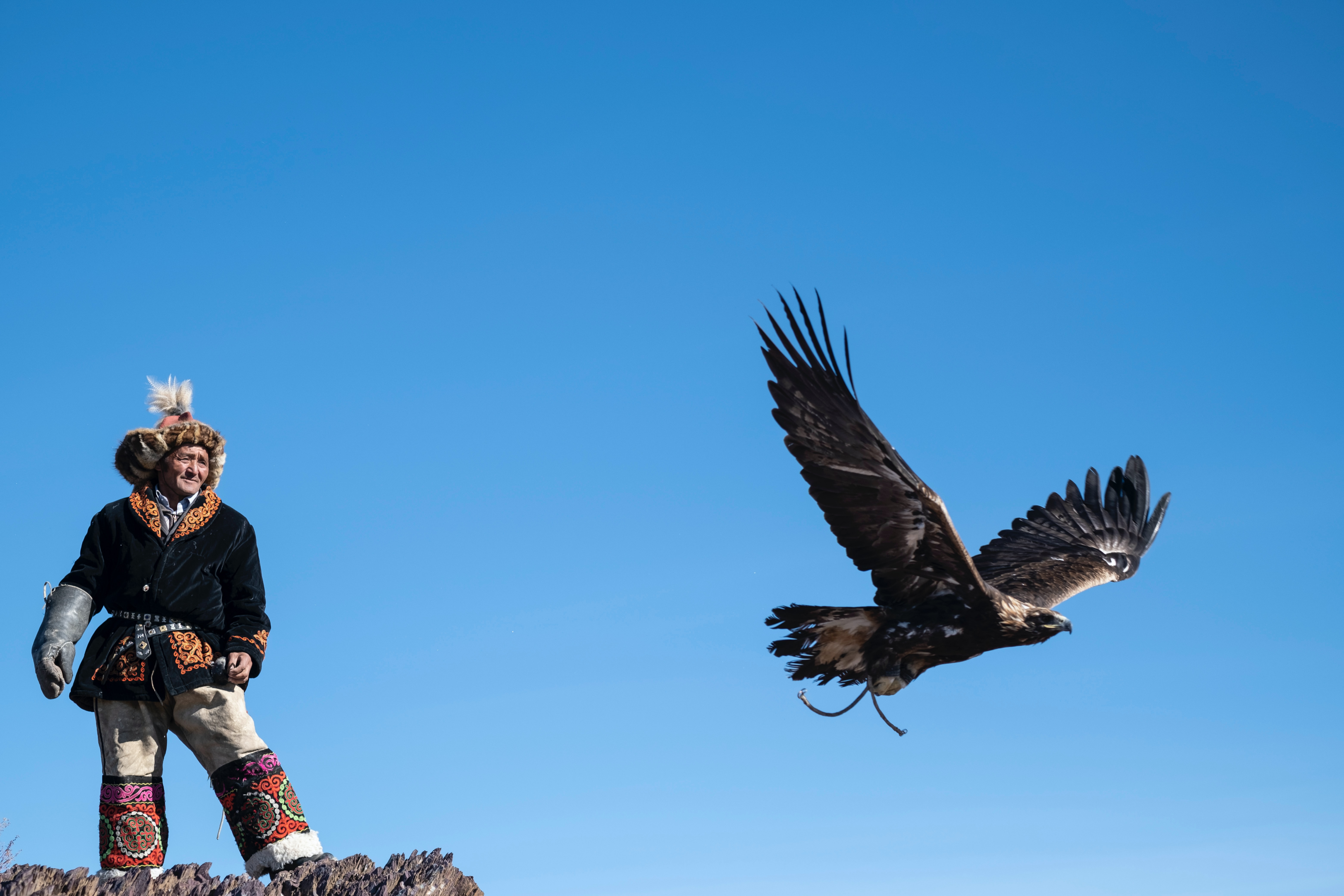
Long before the rise of Genghis Khan, the nomadic tribes of Central Asia practiced the art of eagle hunting, dating back to 2,500 BC. This ancient practice centers around the use of golden eagles, birds renowned for their strength and adaptability, to hunt prey such as foxes and hares. Today, Mongolian Kazakh nomads continue this storied tradition, particularly in the Altai Mountains of western Mongolia, where over 100,000 Kazakh people reside. The Mongolian Eagle Hunters Association helps preserve and promote this age-old tradition, ensuring its survival for future generations.
The Kazakh eagle hunters, known as Burkitshi, live a nomadic lifestyle, migrating several times a year in search of pastureland for their livestock. They maintain a strong bond with their golden eagles, treating them as both hunting partners and cherished family members. The majority of these hunters are male, with an estimated 250 eagle hunters residing in the province of Bayan-lgii. However, there are also female eagle hunters, known as ‘Ayalguu,’ who break traditional gender boundaries and excel in this male-dominated practice.
Eagle hunting is more than just a means of sustenance; it is a living testament to the resilience and adaptability of Kazakh people and their unwavering connection to the natural world. The extraordinary skill, courage, and dedication of the Kazakh eagle hunter and their awe-inspiring birds is sure to captivate as we explore the world of Mongolian eagle hunting further.
The Role of Golden Eagles
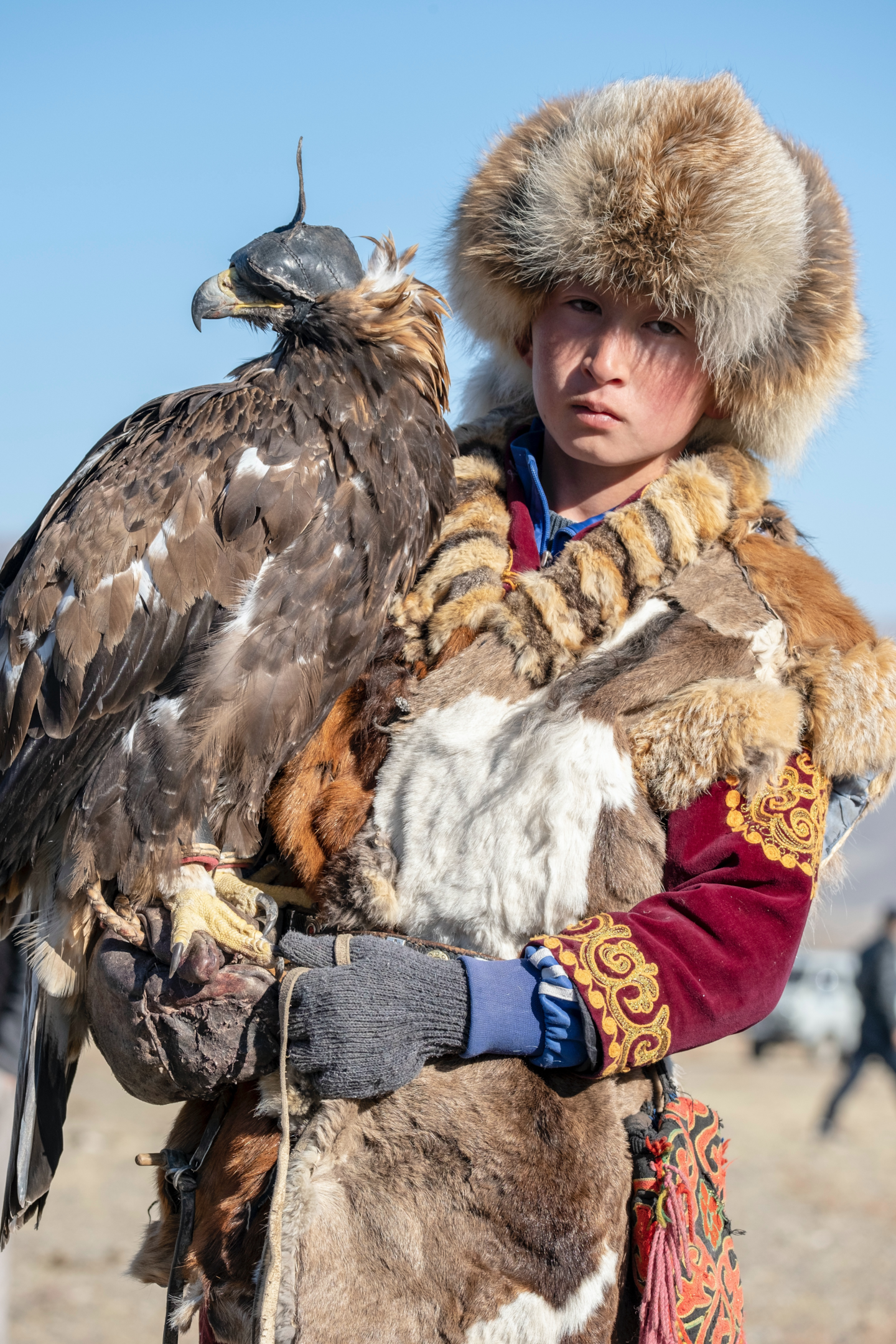
Golden eagles are the cornerstone of Mongolian eagle hunting, prized for their strength, adaptability, and ease of training. These majestic birds boast a wingspan of up to two meters and can reach speeds of up to 200 miles per hour, making them formidable hunters in their own right. The majority of captured eagles used in hunting are between one and four years old, with some living up to thirty years.
Female golden eagles are typically captured from their nests while still young and reared by their hunter-owner. During the summer months, the eagles are tied to a wooden stand or rock and nourished to enhance their vigor. Once the eagle reaches breeding age, it is released as far away as possible from its ‘home’ to dissuade it from returning.
A deep mutual respect and trust characterizes the relationship between the Burkitshi and their golden eagles. The hunters and their birds rely on each other for survival, forging a bond that transcends the mere pursuit of prey. This unbreakable connection is at the very heart of the ancient art of eagle hunting and serves as a reminder of our own intrinsic connection to the natural world.
Training Techniques and Practices
Training a golden eagle for hunting is no small feat, requiring patience, dedication, and a deep understanding of the bird’s natural instincts. The foundation of this golden eagle training lies in the establishment of trust between the hunter and the eagle. Hunters provide sustenance by hand and accompany their eagles on hunts, gradually fostering a strong bond between the two.
In addition to building trust, hunters also teach their eagles essential hunting techniques and utilize distinct sounds to communicate with their birds during hunts. The process of eagle hunting includes:
- Carrying the eagles without hoods to allow them to survey their surroundings
- Releasing the eagle when the hunter detects any body movement or tightening grip on their gloved hand, signaling that the eagle has identified a potential target
- Rewarding the eagle with a piece of meat when it successfully lands on its prey
- Carefully detaching the eagle’s claws from the fur to prevent damage
Eagle hunting is physically and mentally demanding, requiring skill and coordination between the male adult hunters and the eagle, which uses its sharp talons to catch prey.
The training and practice of eagle hunting showcase the dedication, skill, and perseverance of the Burkitshi, who devote their lives to mastering this ancient art. Our ongoing exploration of Mongolian eagle hunting enhances our appreciation for the intricate dance between hunter and bird, a dance that has persisted for millennia.
Life as a Burkitshi: Mongolian Eagle Hunters
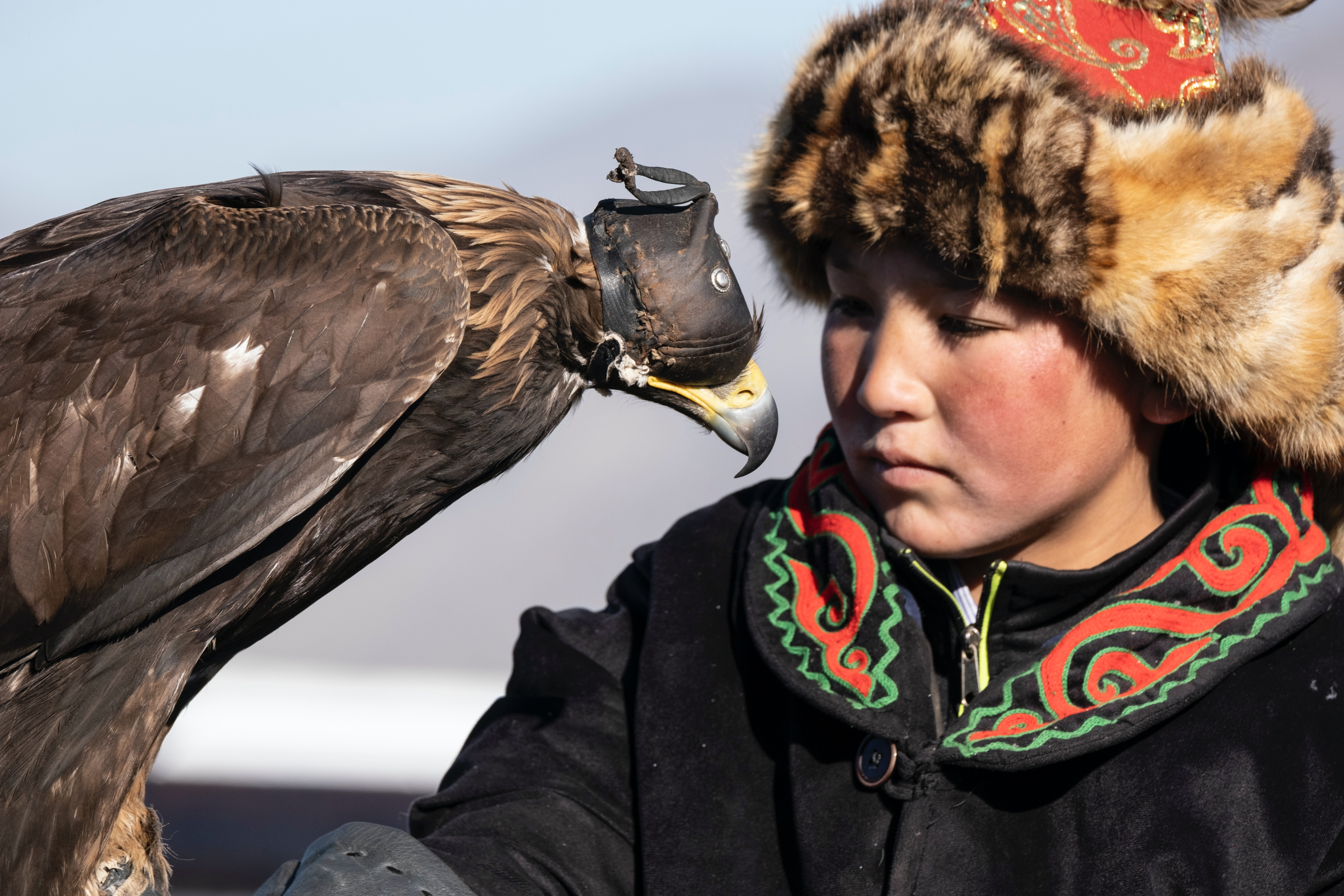
The life of a Burkitshi, or Mongolian eagle hunter, is one of constant movement and adaptation. These nomadic individuals pass down their hunting skills through generations, maintaining a strong connection with their golden eagles and ensuring the continuation of this ancient tradition. Their commitment to preserving this unique way of life speaks to the resilience and determination of the Kazakh people.
One such Burkitshi is Jenisbek Tserik, a semi-nomadic Kazakh residing in the remote westernmost province of Bayan-lgii in Mongolia. His name, meaning “steel warrior,” is a testament to his accomplishments as an accomplished horseman and skilled eagle hunter. Jenisbek has won numerous tug-of-war competitions involving two individuals wrestling a goat carcass and has even been invited to Dubai to participate in exhibition events.
The stories of Burkitshi like Jenisbek showcase the rich cultural heritage of the Kazakh people and the enduring relevance of eagle hunting in their lives. Through their unwavering dedication to this ancient practice, the Burkitshi continue to preserve an important piece of Central Asian history and offer a window into a world that few are privileged to experience.
Female Eagle Hunters: Breaking Boundaries
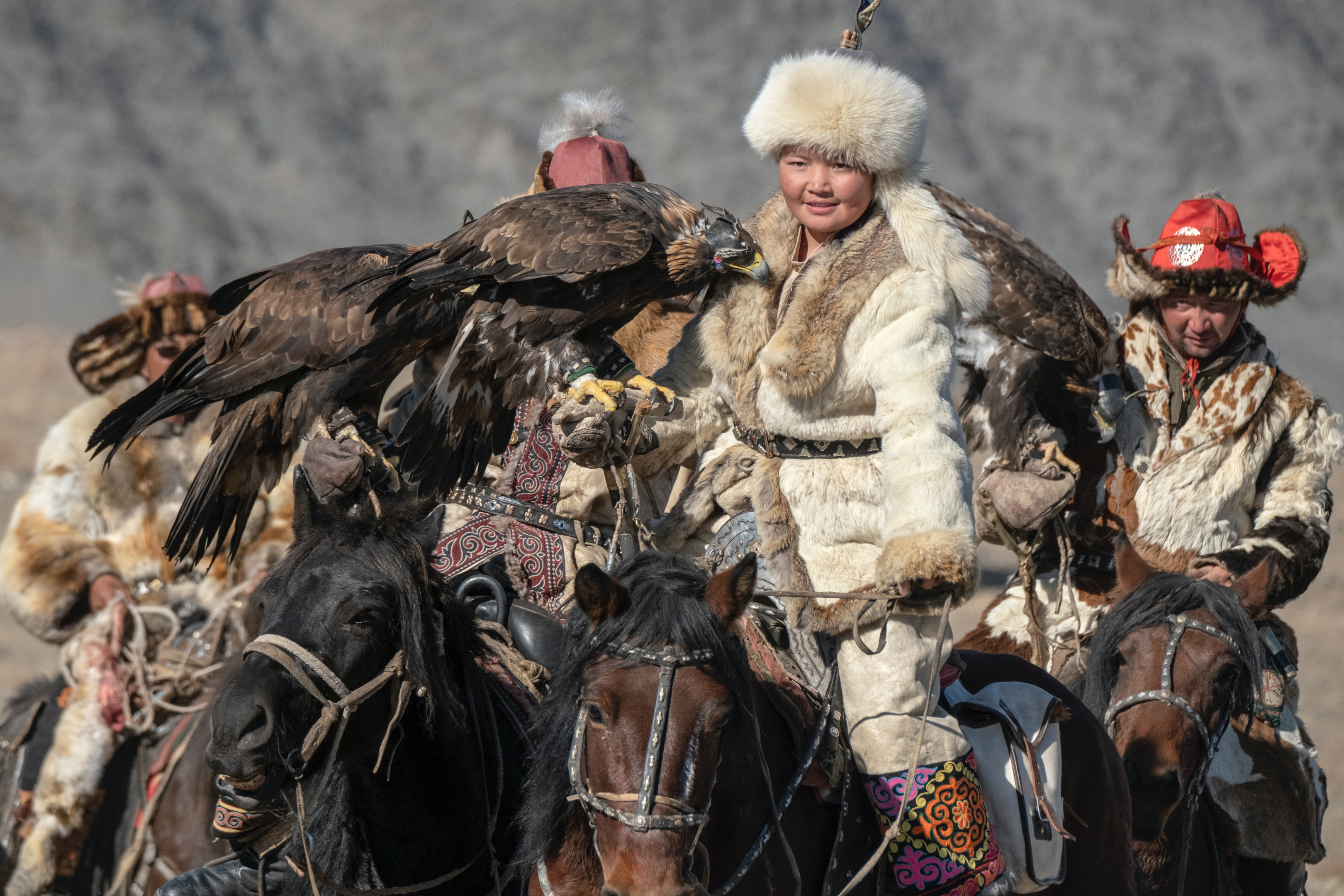
In a world where eagle hunting is predominantly a male-dominated practice, a small number of female eagle hunters, known as ‘Ayalguu,’ are breaking boundaries and proving their skills in this ancient art. With only 11 documented eagle huntresses, these women, including the renowned eagle huntress, are a rare yet inspiring presence in the world of Mongolian eagle hunting.
These female eagle hunters face significant challenges as they navigate a traditionally male-dominated practice. However, their accomplishments and dedication to the art of eagle hunting demonstrate their strength and courage, earning them a place in this ancient tradition. As more women take up the practice, they continue to challenge preconceived notions and forge a path for future generations of female eagles hunters.
With only a handful of women currently engaged in hunting, the future of female eagle hunting in Mongolia remains uncertain. However, as the popularity of eagle hunting grows and more women take up the mantle, there is hope that this incredible tradition will continue to flourish and expand, proving that the art of eagle hunting knows no gender.
The Golden Eagle Festival: A Celebration of Tradition
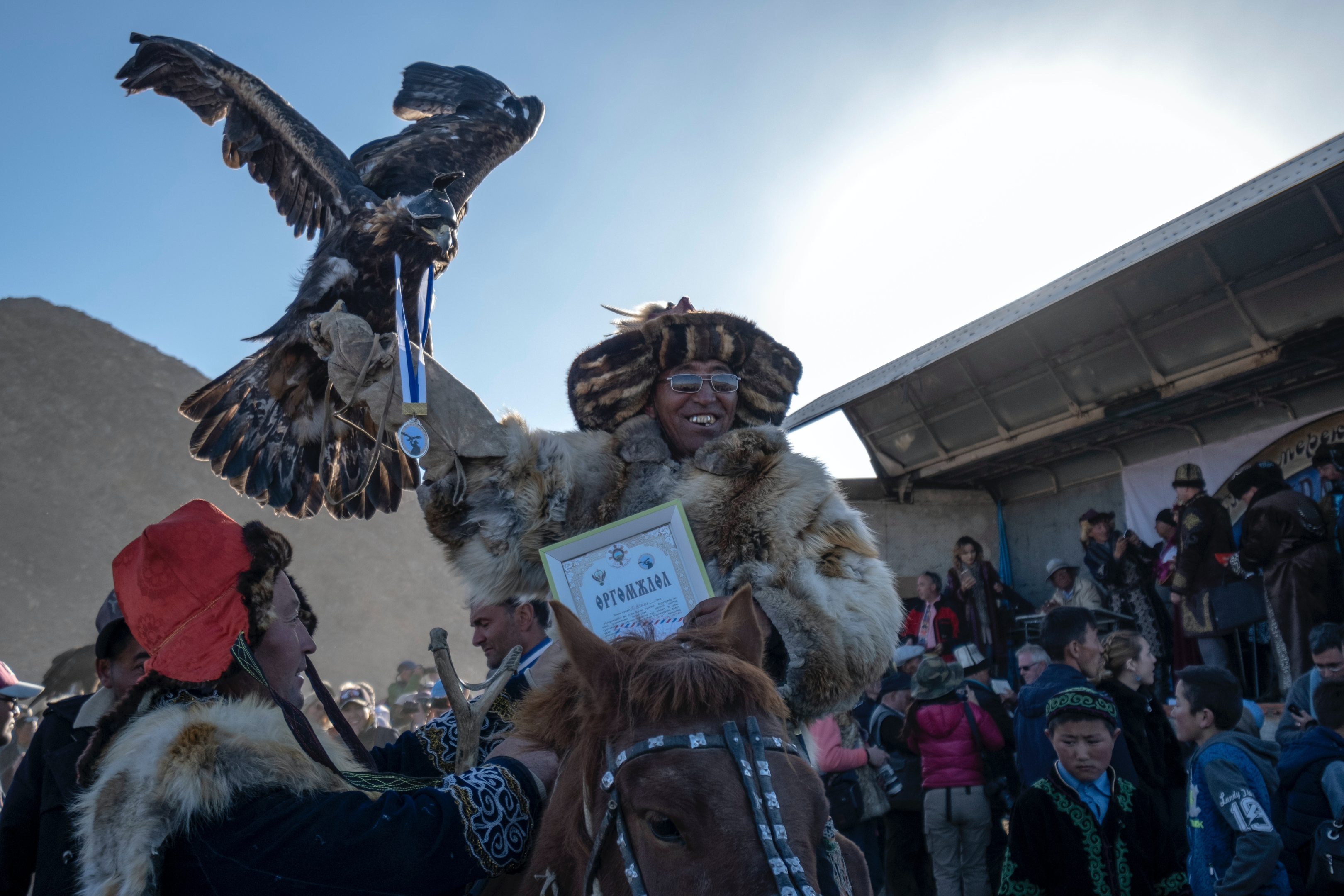
The annual Golden Eagle Festival serves as a vibrant celebration of the ancient art of eagle hunting, showcasing the skills of eagle hunters and their birds in a series of challenges and competitions. Held in the province of Bayan-lgii, the festival draws both locals and tourists alike, providing a unique opportunity to witness this time-honored tradition firsthand.
During the festival, eagle hunters and their birds are tested in various challenges, such as calling the eagle from a distance and having it identify its owner. Speed and technique are also evaluated as the eagles navigate a series of simulated hunting scenarios. These competitions offer a thrilling display of the bond between hunter and bird, a connection honed through years of training and practice.
The Golden Eagle Festival plays a crucial role in promoting and preserving the tradition of eagle hunting, drawing attention to this unique aspect of Kazakh culture and encouraging its continued practice. The festival’s significance and its role in safeguarding Mongolian eagle hunting’s future become increasingly apparent as more people discover this fascinating art.
Responsible Tourism and Cultural Preservation
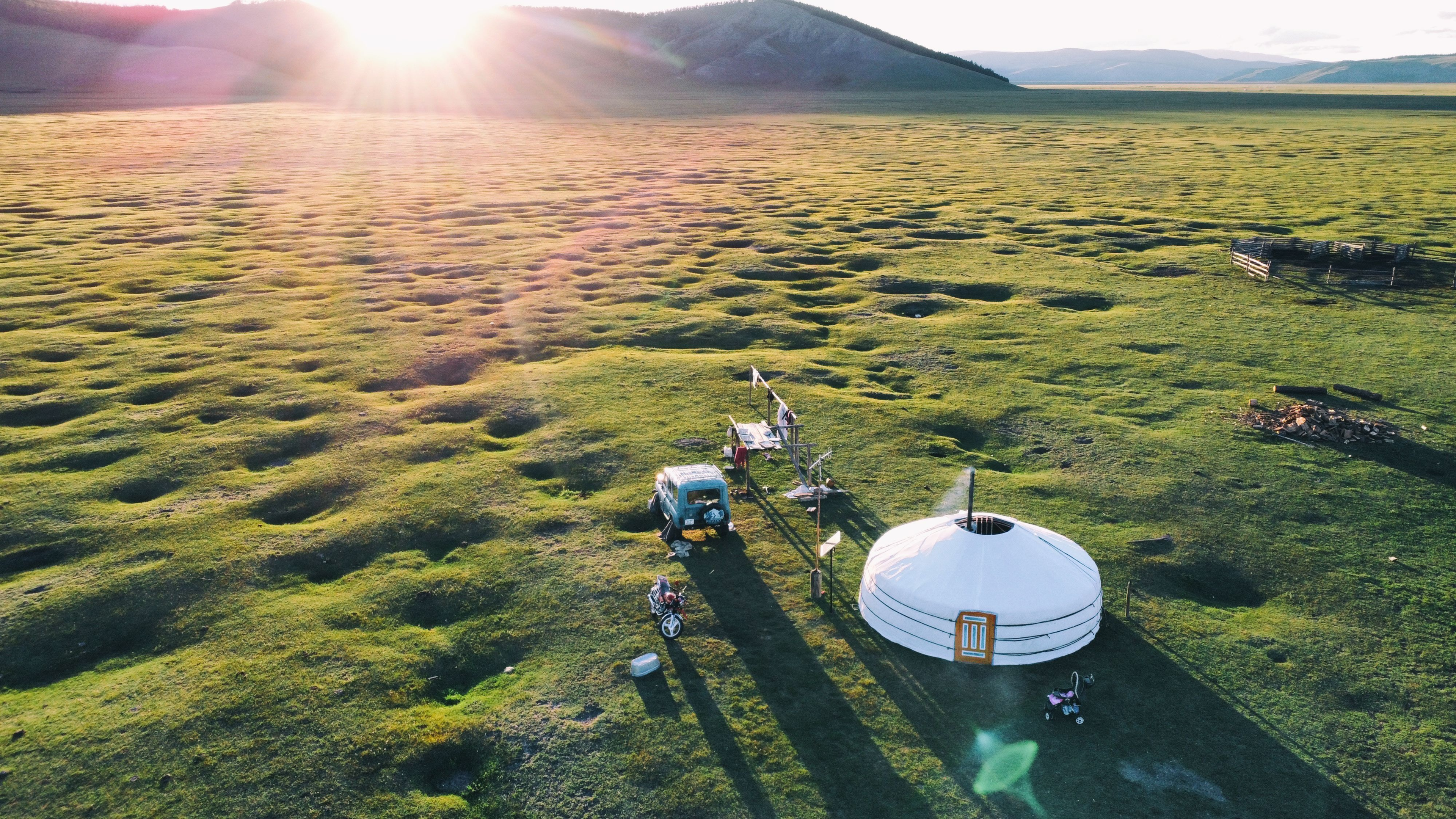
As interest in Mongolian eagle hunting grows, responsible tourism plays a vital role in supporting local communities and ensuring the wellbeing of both the eagle hunters and their birds. Small group tours, such as those offered by Eternal Landscapes, employ local guides with personal connections to the communities and focus on providing a positive impact on the region.
Kazakh eagle hunters maintain a respectful and practical attitude towards their eagles, treating them as cherished family members and releasing them back into the wild after approximately ten seasons to allow for reproduction. This approach ensures the long-term wellbeing of the eagles and helps maintain the delicate balance between tradition and conservation.
However, the presence of tourists can pose challenges for the eagles, such as overcrowding and the potential for stress-related issues. Responsible travelers must remain mindful of their impact on these majestic birds and their environment, striving to make their visits contribute positively to this remarkable tradition’s preservation.
The Future of Mongolian Eagle Hunting
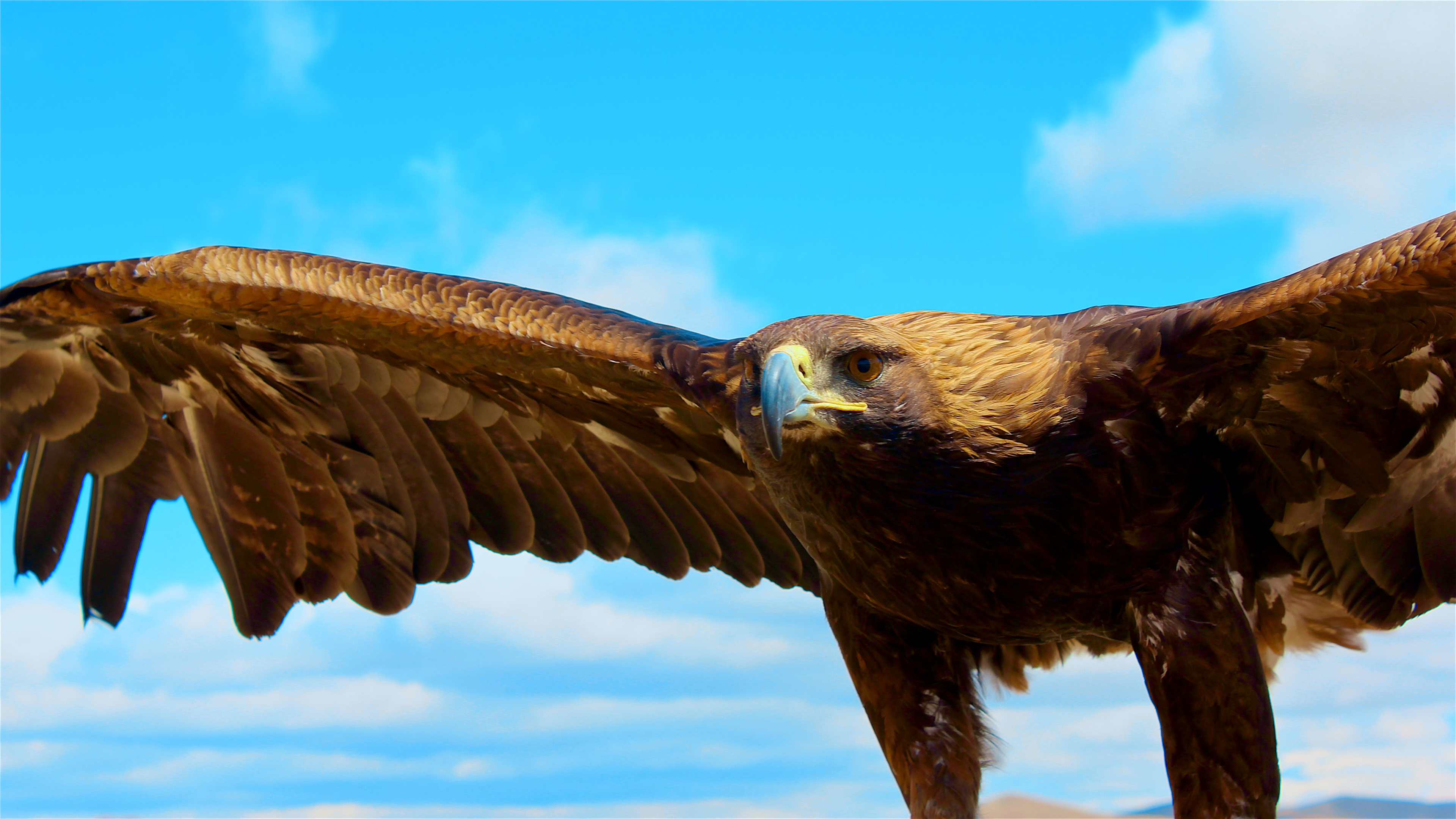
The future of Mongolian eagle hunting faces a number of challenges, including urban migration, climate change, and evolving cultural values. As younger generations move away from traditional nomadic lifestyles, the continuation of this ancient practice becomes increasingly uncertain.
Despite these challenges, efforts are being made to preserve and promote the tradition of eagle hunting through tourism and conservation initiatives. By showcasing the unique skills and traditions of the Kazakh people, these efforts aim to ensure the survival of this ancient art for generations to come.
Continuing to explore and appreciate the world of Mongolian eagle hunting, we must recognize the importance of preserving this unique cultural heritage. By supporting responsible tourism and promoting cultural preservation, we can help ensure that the ancient art of eagle hunting remains a vibrant and thriving tradition for years to come.
Witnessing the Art of Eagle Hunting
There is truly nothing quite like witnessing the art of eagle hunting firsthand in the breathtaking landscapes of Mongolia. From the majestic golden eagles soaring high above the plains to the skilled hunters expertly navigating the rugged terrain, the experience offers a unique and unforgettable glimpse into a world that few are privileged to see.
Visiting an eagle hunter’s family provides an intimate look into their lives and the deep bond they share with their birds. Guests are warmly welcomed into the family’s yurt, offered traditional buttery tea and cakes, and given the opportunity to hold the eagle, take photographs, and ask questions about the art of eagle hunting.
With growing interest in this ancient practice, responsible tourism and cultural preservation efforts become increasingly vital in safeguarding the future of Mongolian eagle hunting. By supporting these initiatives and fostering a deeper understanding of this unique cultural heritage, we can help ensure that the art of eagle hunting remains a vibrant and thriving tradition for generations to come.
How to drive from Ulaanbaatar to the region of Eagle Hunters
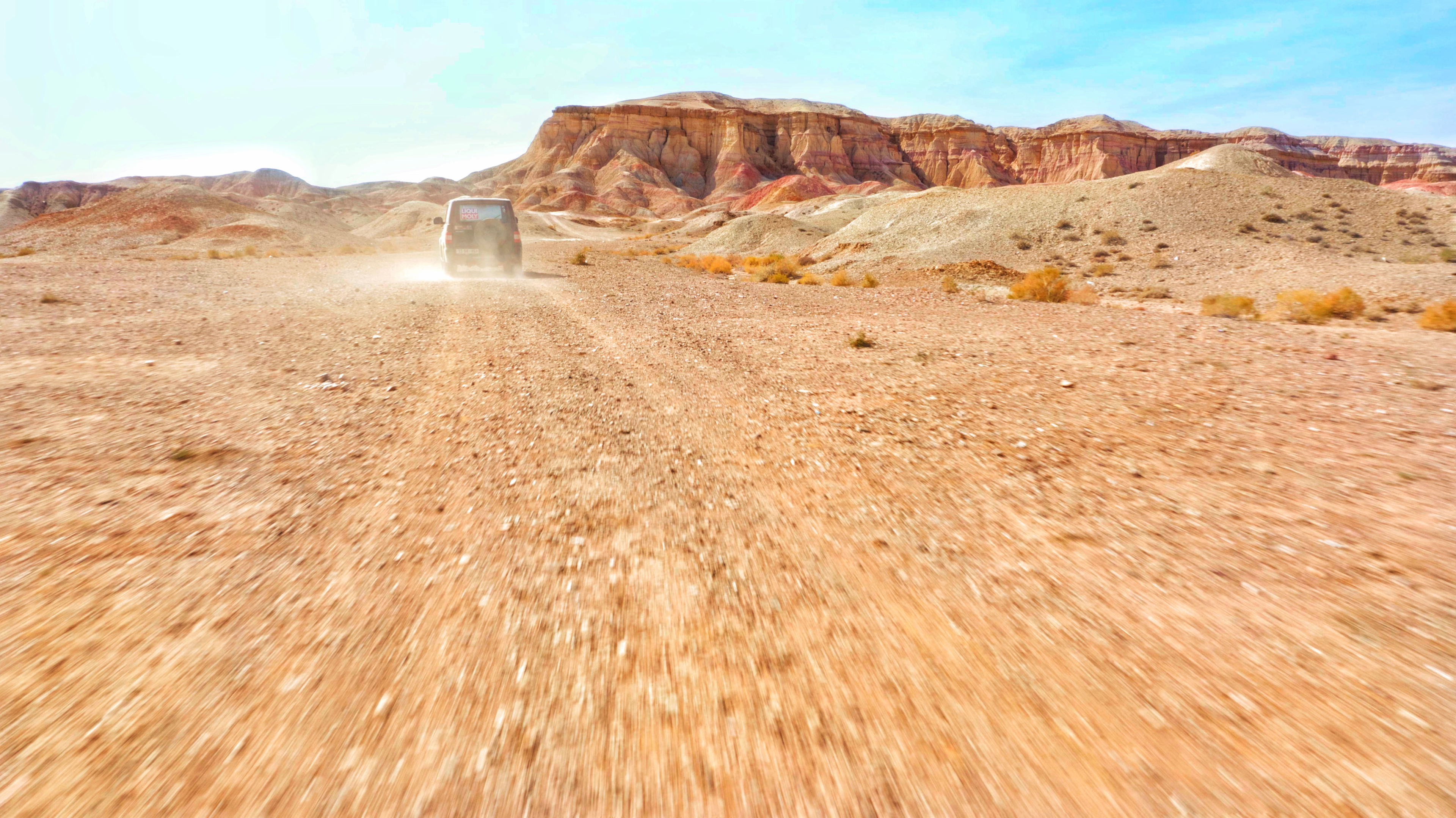
Embarking on a journey from Ulaanbaatar to the region of eagle hunters requires careful planning and navigation, but offers an unparalleled opportunity to explore the stunning landscapes of Mongolia. The drive is estimated to take approximately 20 hours, depending on factors such as weather and road conditions.
Route planning should take into account factors such as the availability of fuel and food, along with the unpredictable nature of Mongolia’s climate. Navigating the route can be achieved through the use of a GPS or map, ensuring that you remain on track and avoid any potential hazards.
The region of eagle hunters is a treasure trove of opportunities for exploration and adventure, providing an unforgettable glimpse into the lives of these skilled hunters and their majestic birds. As you journey through the breathtaking landscapes of Mongolia and witness the ancient art of eagle hunting, you’ll undoubtedly leave with memories that will last a lifetime. Experience the unique world of eagle hunters travel, and immerse yourself in their fascinating culture.

Are you interested in a trip to the eagle hunters?
Summary
The ancient art of Mongolian eagle hunting offers a truly unique and captivating experience, providing a rare glimpse into the lives of skilled hunters and their majestic birds. As we explore this fascinating tradition and its rich cultural heritage, it is essential to recognize the importance of responsible tourism and cultural preservation in ensuring the future of this remarkable practice. By supporting these efforts and fostering a deeper understanding of the world of eagle hunting, we can help preserve this ancient art for generations to come.
Frequently Asked Questions
What is a Mongolian eagle hunter?
The Kazakh burkitshi in Mongolia have been practicing the tradition of eagle hunting from horseback for generations.
This ancient practice is integral to Kazakh culture and has been passed down through generations.
Which Mongolian tribe hunts with eagles?
The Kazakh eagle hunters of Western Mongolia are an ethnic group in Kazakhstan that has been hunting with golden eagles for centuries as a way of surviving during winter months.
This ancient tradition has been passed down from generation to generation, and is still practiced today. The hunters use specially trained eagles to hunt foxes, rabbits, and other small animals. The eagles are trained to swoop down and grab the prey.
How many Mongolian eagle hunters are there?
There are approximately 400 registered eagle hunters in Mongolia, ranging in age from 30 to 70 years old, with the oldest being 88 years old.
What do Mongolian eagle hunters wear?
Mongolian eagle hunters typically wear boots, black coats and ‘loovuuz’ hats made of fox fur, signifying the opening of the hunting season at the mid-October Golden Eagle Festival.
At this festival, eagle hunters from all over Mongolia come together to show off their skills and compete in various competitions. The festival is a celebration of the traditional Mongolian practice of hunting with eagles, which has been passed down through generations.
The Golden Eagle Festival is a great opportunity to witness the Golden Eagle Festival.
What is hunting with eagles called?
Falconry, also known as ‘hawking’, is an ancient practice of hunting game using falcons, hawks, eagles or buzzards. It is particularly prominent in the Eurasian Steppe where it was traditionally practiced by Khitan and Turkic peoples - this form of falconry involving eagles is referred to as ‘eagle hunting’.
Eagle hunting is a unique form of falconry that has been practiced for centuries. It involves the use of trained eagles to hunt game, such as rabbits, foxes, and hares. The hunter must be skilled in the art of hunting.
Request A Car Rental
Travelling to Mongolia and need a car rental plus extra equipments?




